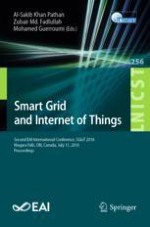This book constitutes the refereed proceedings of the Second EAI International Conference on Smart Grid and Internet of Things, SGIoT 2018, held in Niagara Falls, Canada, Ontario, in July 2018. The 14 papers presented were carefully reviewed and selected from 25 submissions and present research results on how to achieve more efficient use of resources based largely on IoT-based machine-to-machine interactions in the smart grit communication networks. The smart grid also encompasses IoT technologies, which monitor transmission lines, manage substations, integrate renewable energy generation (e.g., solar or wind), and utilize hybrid vehicle batteries. Through these technologies, the authorities can smartly identify outage problems, and intelligently schedule the power generation and delivery to the customers
